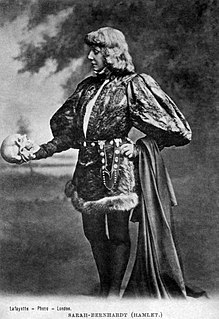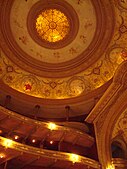
The Teatro Colón is the main opera house in Buenos Aires, Argentina. It is considered one of the ten best opera houses in the world by National Geographic, and is acoustically considered to be amongst the five best concert venues in the world.

Rosario is the largest city in the central Argentina province of Santa Fe. The city is located 300 km (186 mi) northwest of Buenos Aires, on the west bank of the Paraná River. Rosario is the third most populous city in the country, and is also the most populous city in Argentina that is not a provincial capital. With a growing and important metropolitan area, Greater Rosario has an estimated population of 1,276,000 as of 2012. One of its main attractions includes the neoclassical architecture that has been retained over the centuries in hundreds of residences, houses and public buildings.

Palacio de los Leones is the name of the main municipal building of the city of Rosario, Argentina. The Palace is the seat of the executive branch of the municipal government. It is located at the corner of Buenos Aires and Santa Fe Streets, in front of Plaza 25 de Mayo, and separated from the Cathedral by the promenade known as Pasaje Juramento, which leads to the National Flag Memorial.
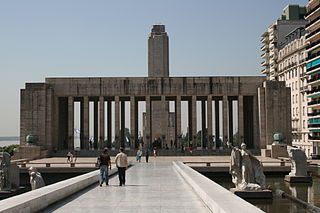
The National Flag Memorial in Rosario, Argentina, is a monumental complex built near the shore of the Paraná River. It was inaugurated on June 20, 1957, the anniversary of the death of Manuel Belgrano, creator of the Argentine flag, who raised it for the first time on an island on the opposite shore of the river on February 27, 1812.

The Cathedral Basilica Shrine of Our Lady of the Rosary is a minor basilica and cathedral dedicated to the local Virgin of the Rosary, in the city of Rosario, province of Santa Fe, Argentina. It is the mother church of the Archdiocese of Rosario.

The Juan B. Castagnino Fine Arts Museum is an art museum in the city of Rosario, province of Santa Fe, Argentina, considered the most important of the interior of the country and the second in national terms. It is administered by the municipal government. The museum lies within the Parque de la Independencia immediately outside the city center, at the intersection of Oroño Boulevard and Pellegrini Avenue.
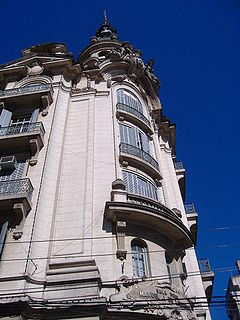
The Sala Lavardén is an important theater in Rosario, province of Santa Fe, Argentina. It is formally called Teatro Provincial Manuel José de Lavardén and is part of the culture center of the same name, in turn administered by the provincial state.
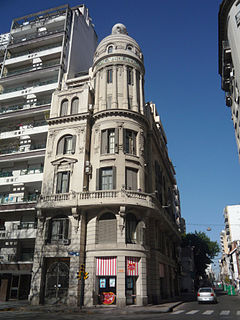
La Bola de Nieve is a historical building in the city of Rosario, Santa Fe Province, Argentina. Its name alludes to the presence of a large stone sphere on its top.

The Palacio Cabanellas is a historical building in the city of Rosario, province of Santa Fe, Argentina. It is located in the downtown area, occupying the southwestern corner of San Luis St. and Sarmiento St.

The Teatro Argentino de La Plata is the second most important lyric opera house in Argentina, after the Teatro Colón in Buenos Aires. The theatre is located in a central block of the city of La Plata, the capital of Buenos Aires Province. The venue occupies the block bounded by the 9 and 10 streets and 51 & 53 avenues; it belongs to the Monumental Axis of public buildings in La Plata.

Enrico Francesco Leopoldo "Enrique" Ferrarese was an Italian Argentine real estate developer.

In Venezuela, since the opening of the Teatro Caracas and, earlier, the Teatro Maderero, there whas been a great lyrical tradition ranging from serious opera to operetta, zarzuela, and Spanish musical reviews.

The Ponce Municipal Library, formally, Biblioteca Municipal Mariana Suárez de Longo, and also known as Biblioteca Publica de Ponce, is the library system of the municipality of Ponce, Puerto Rico. Founded in 1870, it is the oldest public library in Puerto Rico. The system has its main library on Miguel Pou Boulevard, in barrio San Antón, in the city of Ponce, and seven satellite library branches, three in the city's urban area and four spread out in the municipality's rural areas. The main library inaugurated a new building on Bulevar Miguel Pou in August 2007, where the former Puerto Rico District Court building was located.
Buenos Aires is one of the world's great capitals of theater. The Teatro Colón is a national landmark for opera and classical performances; built at the end of the 19th century, its acoustics are considered the best in the world, and is currently undergoing a major refurbishment in order to preserve its outstanding sound characteristics, the French-romantic style, the impressive Golden Room, and the museum at the entrance. With its theatre scene of national and international caliber, Corrientes Avenue is synonymous with the art. It is thought of as the street that never sleeps, and sometimes referred to as the Broadway of Buenos Aires. Many great careers in acting, music, and film have begun in its many theaters. The Teatro General San Martín is one of the most prestigious, along Corrientes Avenue, and the Teatro Nacional Cervantes functions as the national stage theater of Argentina. The Teatro Argentino de La Plata, El Círculo in Rosario, Independencia in Mendoza, and Libertador in Córdoba are also prominent. Griselda Gambaro, Copi, Roberto Cossa, Marco Denevi, Carlos Gorostiza, Alberto Vaccarezza and Mauricio Kartun are a few of the more prominent Argentine playwrights. Julio Bocca, Jorge Donn, José Neglia, and Norma Fontenla are some of the great ballet dancers of the modern era.

Raffaele Cardone is an Italian-born operatic tenor and the founder and Artistic Director of Miami Lyric Opera.
The Puerto Rican Traveling Theater is a theater company based at the 47th Street Theater in New York City. It was founded as El Nuevo Círculo Dramatico by Míriam Colón and Roberto Rodríguez.

Eduardo Le Monnier was a French architect recognized for his work in Brazil, Uruguay and mostly the Argentina.

